May 2017 was , with the exception of just a couple of inclement days, almost perfect for wildlife watching in this area. With high pressure dominating, we enjoyed plenty of dry, sunny and still days, with just a few frosty starts, and with around 18 hours of usable daylight, and all of our summer visiting birds now arrived, our full-day bird species day-lists climbed ever higher, with 60+ species a realistic proposition, and early starts for the Black Grouse 'leks', also helping us to see up to 10 different mammals in a day too!!
 |
| The view west from Cairngorm Mountain Summit |
To give you an idea of what you may realistically hope to see if you are planning a future May visit, I hope the following more detailed information, illustrated with photos taken at sites in and around the Cairngorms National Park by myself, my friends or my safari clients, will help....clicking on the picture enlarges it to full-screen.
Local speciality and upland bird species seen regularly throughout the month included:
Black Grouse (pre-dawn start required), Red Grouse, Osprey, Ring Ouzel, Slavonian Grebe, Red-Throated Diver, Black-Throated Diver, Goldeneye, Crossbill, and Dipper.
We also had a few decent sightings of Golden Eagle and White-Tailed Eagle....a couple of brief pre-dawn views of Barn Owl, and a solitary sighting of a Short-Eared Owl...
A mountain-top adventure on the 17th, produced super views of both Ptarmigan and Dotterel...
Capercaillie, despite several visits to the RSPB Loch Garten Caper-watch, sadly, again proved to be very elusive, and It should also be noted that, due to their very secretive nature at nesting time , Crested Tits continued to be extremely difficult to see during their breeding season (April-May), and we struggled to see them until they fledged young late in the month....
Mammals seen regularly by my safari parties during the month included:
Rabbit, Brown Hare, Mountain Hare (now a mottled grey), Red Squirrel, Roe Deer, Red Deer, Reindeer, Mountain Goat, and Bank Vole , whilst we also had a couple of brief glimpses of Stoat and Weasel...but.... 'mammal of the month' has to be the very mean looking Scottish Wildcat we saw skulking around near a field full of nesting waders, soon after dawn on the 24th... an amazing treat for my American safari clients, who, being experienced travelling wildlife-watchers, fully appreciated what a very fortunate, rare and privileged reward it was for their early start....
Wildlife highlights included:
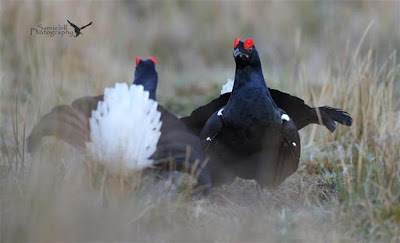 |
| Duelling Black Grouse (taken by Nigel Wedge from a hide) |
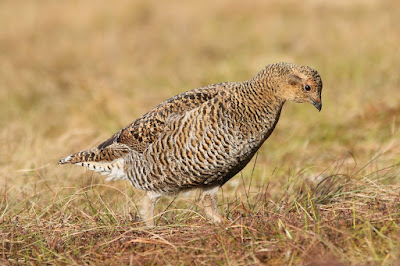 |
| Female Black Grouse (Taken by Steve Nicklin from a hide) |
Black Grouse 'lekking' is surely one of British wildlife's top 10 sights (and sounds), and our local birds continued to 'perform' throughout the month, with up to 10 cock birds fighting it out, with a few females 'spectating' early in the month, though with dawn at around 4 am, and the performance only lasting for around 70 minutes on average, it should be noted that a very early start is needed if you want to see them...and that we have to view from a respectful distance....(the picture above was taken from a hide).....but with a quality spotting scope, this is still a highly recommended and memorable experience, especially as on a few occasions, we had a supporting cast of Short-Eared Owl and Barn Owl hunting across the moors and fields close to the lek site!!!
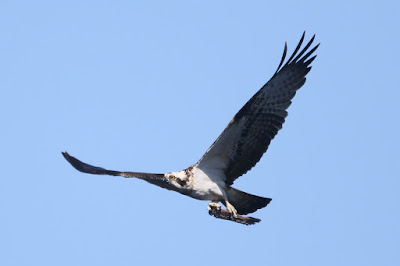 |
| Osprey by Steve Nicklin |
Our local Ospreys continued to entertain my safari clients, often being voted 'Bird of the day', though with the female birds spending much of the month deep in their nests incubating eggs with just their heads visible, and later in the month, brooding young, sightings could be a bit frustrating, as we needed a bit of luck to time our visit with the male birds arrival to deliver a fish or more nest-building materials.....though we did also see birds fishing local lochs and rivers on several occasions... always a treat....
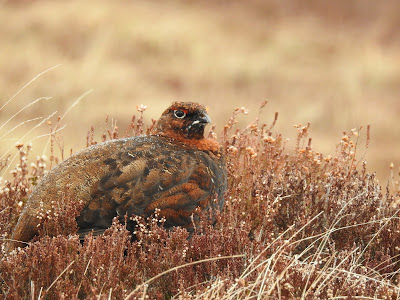 |
| Red Grouse |
On our local heather moorlands, the Red Grouse continued to show well, with some cock birds even still displaying and calling, their guttural 'go bak go bak' calls echoing across the moor, and late in the month we began to see the hen birds with their newly fledged families of up to 8 very cute fluffy youngsters...
 |
| Ring Ouzel |
Ring Ouzels were seen regularly in their upland habitat, especially early in the day, though they now became a little harder to find as most were no longer singing or calling, and sightings were mainly restricted to male birds collecting beakfuls of worms, as the females were mostly on nests.....
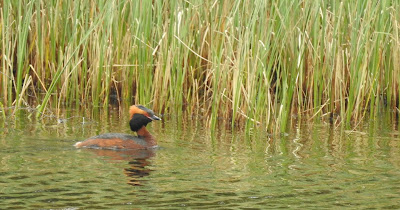 |
| Slavonian (Horned) Grebe |
The extremely beautiful (and incredibly rare) Slavonian Grebes were again seen and enjoyed regularly on suitably undisturbed local lochs, with the male birds seen fishing and delivering food to the nests hidden in the bankside sedge beds.....lets keep our fingers crossed for a glimpse of some youngsters soon, for a bird that is only just clinging on as a breeding species in the UK.....
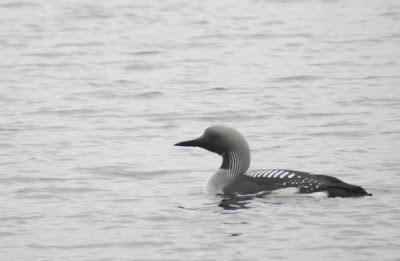 |
| Black-Throated Diver |
Still on the lochs, Red-Throated and Black-Throated Divers too, UK-wise, are only really found breeding, and in their dapper summer plumage, on suitable lochs in northern Scotland. Due to their general waryness of humans, most views we get are through a scope at a fair distance, and any decent ripple on the water makes finding them very difficult, but on a number of occasions, and with a little persistence, we got lucky and obtained a slightly closer look, and even managed a few rare photo opportunities....
 |
| Drake Goldeneye |
The same could be said of our Goldeneye, with this attractive tree-nesting duck being a north of Scotland breeding speciality too, and late in the month we got to see a few with their ridiculously cute youngsters too... nice!
 |
| Adult Dipper |
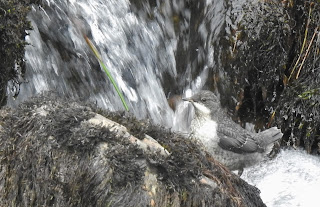 |
| Young Dipper |
Dippers are always popular with my safari clients, being absent from large parts of the central, eastern and southern UK, and from mid-month we saw the parent birds flying back to their nests with beaks full of insects, and later on we got to see the very cute newly fledged youngsters out and about ( and instinctively 'dipping'!) on the rivers with their parents for the first time this year....
 |
| Male Scottish Crossbill |
Scottish Crossbills are all too often the cause of much frustration on my safaris, with me regularly hearing their distinctive 'jip' jip' jip' calls overhead, and my safari clients getting just a brief glimpse of the birds flying away, usually never to be seen again! But on a number of occasions this month, they were actually very obliging, with us getting some super views, sometimes even through the scope, of family parties feeding together on pine cone seeds, giving us the chance to admire the brick-red males, greeny-yellow females and streaky youngsters - marvellous stuff!
Golden Eagle and White-Tailed Eagle are iconic 'Scottish' birds which always seems to be on visiting birders 'wish-lists', and we are fortunate to have a number of suitable upland glens nearby, however.... it should be noted that, with most females on eggs, and 18+ hours of daylight available for the males and sub-adults to use for hunting, the chances of us just happening to be in the right place at the right time to see one are are fairly low during spring and summer(when compared to the autumn/winter months) , we did however manage to get a few decent if generally distant views, though photo opportunities were very limited....
Other birds of prey seen at least once on my safaris this month included Common Buzzard, Kestrel, Peregrine, Sparrowhawk, Red Kite, Barn Owl and Short-Eared Owl.....
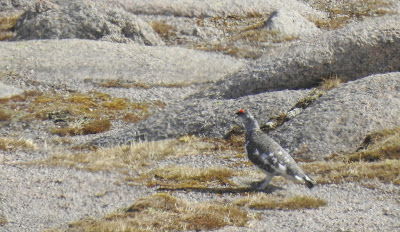 |
| Ptarmigan |
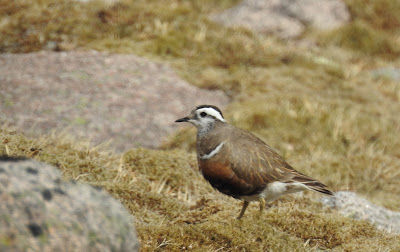 |
| Dotterel |
May, along with June and July are the best months to have a chance of seeing all 3 of our mountain top bird species in one visit, and a walk up and around Cairngorm summit on the 17th - using my Cairngorm Mountain Birdwatching Guide qualification to allow us to use the funicular railway (saving a strenuous uphill walk of 1-2 hours) and then exit the (usually) closed system, gave us decent views of Ptarmigan and super close-ups of Dotterel ....though Snow Bunting eluded us.....
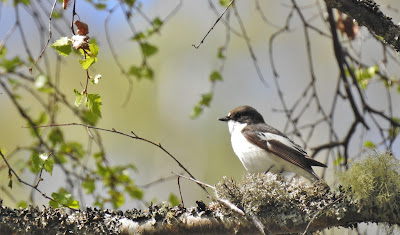 |
| Pied Flycatcher |
Other good birds of note seen locally this month included Cuckoo, Woodcock, Golden Plover, Redstart, Spotted Flycatcher, Pied Flycatcher, Grasshopper Warbler and Wood Warbler, some of which can be tricky to see in large parts of the UK....
 |
| Wood Warbler |
Onto mammals now....
 |
| Mountain Hare |
Our local Mountain Hares, though they are now in their mainly grey Spring outfits, with just their legs and bellies still retaining a hint of white, were again popular with my safari clients, probably because being animals of remote upland habitat, they are not easily accessible to most UK wildlife-watchers... and they were often voted 'mammal of the day'....
 |
| Can you spot the well-camouflaged feral Mountain Goats? |
The same could also be said of our Feral Mountain Goats and we were lucky enough to have many good views of these wild looking, multi-coloured creatures, with their youngsters now almost as big as the adults...
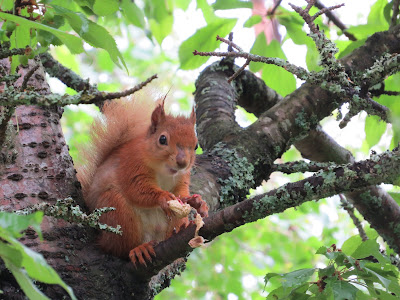 |
| Red Squirrel |
Red Squirrels though, usually bring an "aaaahhh" from my safari clients, and it is unusual for us not to see at least one, and often more of these now very localised but always charismatic little animals whilst on our travels....
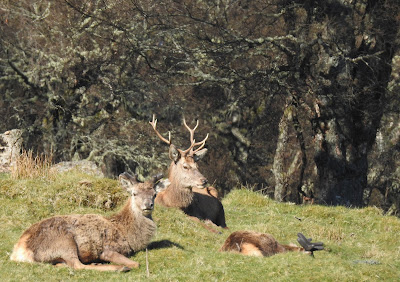 |
| Red Deer |
It's always good to see Deer too, and early starts and a variety of different habitats on the itinerary can give us the chance of seeing up to four different species, though it is usually the local speciality Red Deer and (re-introduced) Reindeer that prove to be the most popular....
 |
| A beautiful local loch |
Well! What a month that was! As well as being my busiest ever May for safaris (a big thank you to all my clients!), now I have finally had time to sit back and reflect, whilst putting together this report, I think it must rate as one of my most memorable too... for the sheer enjoyment of being in such a beautiful part of the world, at (in my opinion) the best time of year, in majestic and incredibly varied, largely unspoilt scenery, sharing marvellous wildlife sightings with fellow wildlife enthusiasts from around the world.... as far as 'job- satisfaction' goes, this'll do for me, thank you!
If you think you know someone who may enjoy a taste of what I do, why not treat them to a safari gift certificate. They make a thoughtful and imaginative present and are available for any amount in multiples of £10, and are valid at any time within a year from date of purchase....
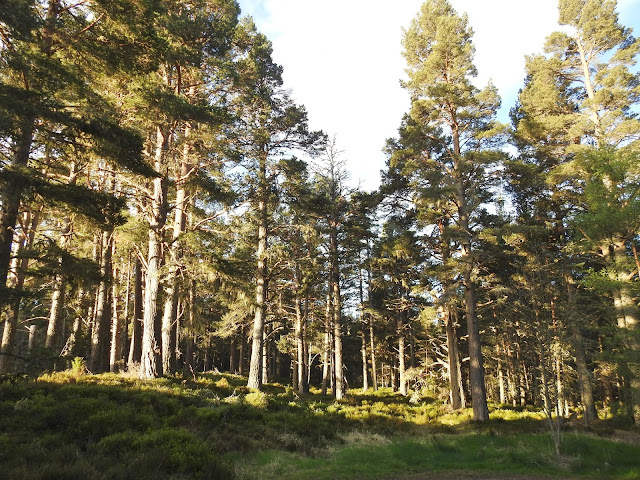 |
| Early morning in a beautiful Caledonian pine forest |










